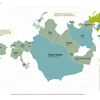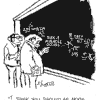5.2.2008 | 09:20
Men No Longer Needed?: Scientists Use Female Adult Stem Cells to Create "Female Sperm"
http://www.lifesite.net/ldn/2008/feb/08020103.html
By John Jalsevac
U.K., February 1, 2008 (LifeSiteNews.com) - "'Female sperm', 'male eggs' and 'same-sex reproduction' - whether these terms fill you with hope or disgust, a reproductive revolution is already in progress," begins a recent New Scientist report on some of the most bizarre and disturbing scientific research being conducted by stem cell scientists.
"In a handful of labs across the world, biologists are trying to make genetically male cells develop into eggs, and female cells into sperm. If successful, their efforts might one day allow lesbian and gay couples to have children that are genetically their own," the report continues.
Scientists at Newcastle upon Tyne University in the U.K. claim to have already used adult stem cells to create primitive sperm, reports New Scientist. Karim Nayernia, a stem-cell biologist at Newcastle, made adult stem cells derived from male bone marrow develop into spermatogonia, and then coaxed the spermatgonia to undergo meisois, thereby becoming mature sperm with sufficient genetic information to impregnate a human egg.
According to the New Scientist report, Nayernia claims to have developed the spermatogonia from female bone marrow as well, but has not yet been able to make the female spermatogonia undergo meiosis.
Theoretically, were Nayernia to be successful in his attempt to create "female sperm", a lesbian couple could give birth to a child that is a composite of both of the partner's genetic material, with no man having contributed to the process of procreation.
Scientists are also working on developing a human egg from male stem cells. In such a scenario it would be possible that a human egg would be made using skin cells of one of the male partners in a homosexual relationship, which would then be impregnated with the sperm of the other partner. The fertilized embryo would then be implanted in the womb of a surrogate mother.
In Brazil, stem-cell scientist Irina Kerkis claims to have already created sperm and eggs from male mouse embryonic stem cells. "We are starting experiments with human embryonic stem cells," Kerkis told New Scientist.
At the same time, in the U.S., patent analyst Greg Aharonian is attempting to obtain a patent for technologies that would allow scientists to create sperm or eggs, allowing same-sex couples thereby to have their own children.
In his patent application, Aharonian states, "The present invention includes methods for developing sperm containing a female's chromosomes, or developing eggs containing a male's chromosomes, and the sperm or eggs so produced."
In the "background to the invention" section of the application, Aharonian claims that this technology could overcome the "only" objection to allowing same-sex couples to "marry" - that is, their present inability to procreate.
"The main, if not only, objective reason for opposing same-sex marriage is that same sex procreation is impossible - two men cannot conceive a child that has genetic material only from both men, and similarly for two women," writes Aharonian.
"But is same sex procreation impossible, so that same-sex couples are forever denied equal protection under marriage laws? Or like brain surgery, face transplants and other 'unnatural' medical technologies, are there clinical techniques to achieve same-sex procreation?"
Aharonian told the New Scientist, "I'm a troublemaker."
As with most stem-cell technologies, however, there are safety concerns about the process. Reportedly Nayernia pioneered his "female sperm" techniques first on mice, impregnating female mouse eggs with sperm derived from female stem cells. The mice that were subsequently born, however, suffered severe health problems.
One other problem with creating "female sperm" is that such sperm would always lack the Y chromosome necessary to conceive a male child. Hence the process could only ever produce a female child.
There are also still a host of technological problems to be solved, which has lead some scientists to conclude that useable "female sperm" and "male eggs" are still a long ways off. "I think it will take far more than 10 years," said Robin Lovell-Bade of the London-based National Institute for Medical Research.
Um bloggiš
Baldur Fjölnisson
Nżjustu fęrslur
- Torfi Stefįns bannašur ęvilangt
- OL ķ skįk. Landinn malaši Kenķu ķ 9. umferš
- OL ķ skįk: Landinn ķ 88. sęti eftir 8 umferšir
- Mešaljónar ķ skįkinni
- Baggalśtur - Sagan af Jesśsi
- Eitraš fyrir lżšnum?
- Óvenjulega döpur taflmennska innfęddra einkennir Reyjavķkursk...
- U.S. Rushes Coolant to Japanese Nuke Plant After Earthquake
Heimsóknir
Flettingar
- Ķ dag (18.9.): 0
- Sl. sólarhring: 1
- Sl. viku: 8
- Frį upphafi: 0
Annaš
- Innlit ķ dag: 0
- Innlit sl. viku: 7
- Gestir ķ dag: 0
- IP-tölur ķ dag: 0
Uppfęrt į 3 mķn. fresti.
Skżringar
Bloggvinir
-
 Agný
Agný
-
 Alfreð Símonarson
Alfreð Símonarson
-
 Andrea J. Ólafsdóttir
Andrea J. Ólafsdóttir
-
 Bjarni Harðarson
Bjarni Harðarson
-
 Bjarni Kjartansson
Bjarni Kjartansson
-
 Björgvin Gunnarsson
Björgvin Gunnarsson
-
 Brynjar Jóhannsson
Brynjar Jóhannsson
-
 FLÓTTAMAÐURINN
FLÓTTAMAÐURINN
-
 Eygló Þóra Harðardóttir
Eygló Þóra Harðardóttir
-
 FreedomFries
FreedomFries
-
 Fríða Eyland
Fríða Eyland
-
 Félag um stafrænt frelsi á Íslandi
Félag um stafrænt frelsi á Íslandi
-
 Georg P Sveinbjörnsson
Georg P Sveinbjörnsson
-
 Gestur Guðjónsson
Gestur Guðjónsson
-
 Gils N. Eggerz
Gils N. Eggerz
-
 Gullvagninn
Gullvagninn
-
 Gunnar Skúli Ármannsson
Gunnar Skúli Ármannsson
-
 Guðrún María Óskarsdóttir.
Guðrún María Óskarsdóttir.
-
 Gísli Hjálmar
Gísli Hjálmar
-
 Hagbarður
Hagbarður
-
 Halla Rut
Halla Rut
-
 Haraldur Haraldsson
Haraldur Haraldsson
-
 Hilmar Kári Hallbjörnsson
Hilmar Kári Hallbjörnsson
-
 Hlekkur
Hlekkur
-
 Ingibjörg Álfrós Björnsdóttir
Ingibjörg Álfrós Björnsdóttir
-
 Jens Guð
Jens Guð
-
 Jóhannes Ragnarsson
Jóhannes Ragnarsson
-
 Jón Aðalsteinn Jónsson
Jón Aðalsteinn Jónsson
-
 Jón Ragnarsson
Jón Ragnarsson
-
 Jón Steinar Ragnarsson
Jón Steinar Ragnarsson
-
 Jónína Benediktsdóttir
Jónína Benediktsdóttir
-
 Karl Tómasson
Karl Tómasson
-
 Kári Magnússon
Kári Magnússon
-
 Loopman
Loopman
-
 Magnús Þór Hafsteinsson
Magnús Þór Hafsteinsson
-
 Promotor Fidei
Promotor Fidei
-
 Rúnar Sveinbjörnsson
Rúnar Sveinbjörnsson
-
 Salvör Kristjana Gissurardóttir
Salvör Kristjana Gissurardóttir
-
 Sandra María Sigurðardóttir
Sandra María Sigurðardóttir
-
 SeeingRed
SeeingRed
-
 Sigurbjörn Friðriksson
Sigurbjörn Friðriksson
-
 Sigurjón Þórðarson
Sigurjón Þórðarson
-
 Sigurður Þórðarson
Sigurður Þórðarson
-
 Snorri Hrafn Guðmundsson
Snorri Hrafn Guðmundsson
-
 el-Toro
el-Toro
-
 Sveinn Ingi Lýðsson
Sveinn Ingi Lýðsson
-
 Tryggvi Hjaltason
Tryggvi Hjaltason
-
 TómasHa
TómasHa
-
 Túrilla
Túrilla
-
 Upprétti Apinn
Upprétti Apinn
-
 gudni.is
gudni.is
-
 haraldurhar
haraldurhar
-
 proletariat
proletariat
-
 Ívar Pálsson
Ívar Pálsson
-
 Ómar Ragnarsson
Ómar Ragnarsson
-
 Ónefnd
Ónefnd
-
 Óskar
Óskar
-
 Óskar Helgi Helgason
Óskar Helgi Helgason
-
 Óskar Þ. G. Eiríksson
Óskar Þ. G. Eiríksson
-
 Þórir Kjartansson
Þórir Kjartansson
-
 Arnar Guðmundsson
Arnar Guðmundsson
-
 Bara Steini
Bara Steini
-
 Birgir R.
Birgir R.
-
 Birgir Rúnar Sæmundsson
Birgir Rúnar Sæmundsson
-
 brahim
brahim
-
 Brosveitan - Pétur Reynisson
Brosveitan - Pétur Reynisson
-
 Bwahahaha...
Bwahahaha...
-
 Dingli
Dingli
-
 eysi
eysi
-
 Gestur Kristmundsson
Gestur Kristmundsson
-
 Guðbjörg Elín Heiðarsdóttir
Guðbjörg Elín Heiðarsdóttir
-
 Gunnar Helgi Eysteinsson
Gunnar Helgi Eysteinsson
-
 Gunnar Rögnvaldsson
Gunnar Rögnvaldsson
-
 Helgi Jóhann Hauksson
Helgi Jóhann Hauksson
-
 Hlini Melsteð Jóngeirsson
Hlini Melsteð Jóngeirsson
-
 Jakobína Ingunn Ólafsdóttir
Jakobína Ingunn Ólafsdóttir
-
 Katrín Snæhólm Baldursdóttir
Katrín Snæhólm Baldursdóttir
-
 kreppukallinn
kreppukallinn
-
 Kristín Magdalena Ágústsdóttir
Kristín Magdalena Ágústsdóttir
-
 Máni Ragnar Svansson
Máni Ragnar Svansson
-
 Morgunblaðið
Morgunblaðið
-
 Neo
Neo
-
 Orgar
Orgar
-
 Ragnar L Benediktsson
Ragnar L Benediktsson
-
 Rauði Oktober
Rauði Oktober
-
 Skákfélagið Goðinn
Skákfélagið Goðinn
-
 Sveinn Þór Hrafnsson
Sveinn Þór Hrafnsson
-
 Vilhjálmur Árnason
Vilhjálmur Árnason
-
 Þór Ludwig Stiefel TORA
Þór Ludwig Stiefel TORA




Athugasemdir
Female sperm gengur aldrei, en male eggs tónar betur viš brjįluš plön elķtunnar. Held samt aš žeir muni halda žessu ķ śtungunarvélum, en aušvitaš žurfa žeir aš gręja žessa tękni til aš gera vélarnar sķnar. Svo er bara aš snśa sveifinni, viltu buršaržręl, žjónustužręl, kynlķfsžręl... allt karldżr en meš kvenlegu ķvafi, svona eins og skrattinn, svoldiš tvķkynja.
Gullvagninn (IP-tala skrįš) 5.2.2008 kl. 10:02
Jį, er ekki eins og karlmenn séu aš breytast ķ kvenfólk og öfugt ?
Metrómašurinn sįlugi kann aš hafa veriš eins konar "predictive programming" ķ žvķ sambandi.
Baldur Fjölnisson, 5.2.2008 kl. 10:47
Jś, karlmenn hafa misst talsvert af fyrri karlmennsku sinni, meš simulerušum kvenhormónum śr plastumbśšum, meš flśor og öšrum eitrum til aš taka uppreisnarbroddinn śr, og svo aušvitaš meš massķvri predicitve programming herferš, žar sem karlmašurinn er sżndur sem bjóržambandi sjónvarpsglįpandi heimskingi.
Gullvagninn (IP-tala skrįš) 5.2.2008 kl. 19:00
Bęta viš athugasemd [Innskrįning]
Ekki er lengur hęgt aš skrifa athugasemdir viš fęrsluna, žar sem tķmamörk į athugasemdir eru lišin.